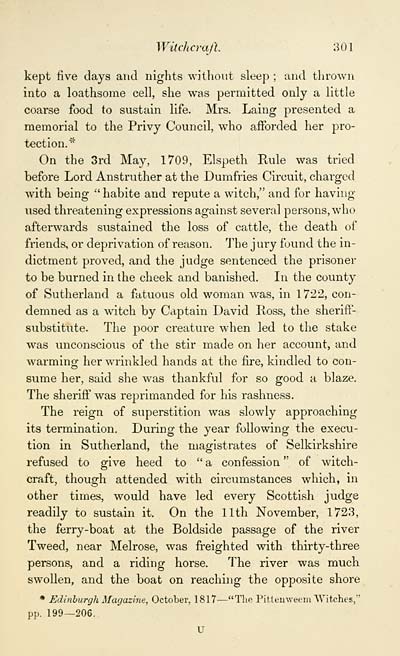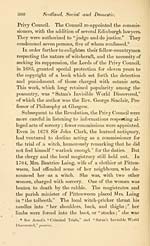Grampian Club > Scotland, social and domestic
(307) Page 301
Download files
Complete book:
Individual page:
Thumbnail gallery: Grid view | List view

Witchcraft. 301
kept five days and nights without sleep ; and thrown
into a loathsome cell, she was permitted only a little
coarse food to sustain life. Mrs. Laing presented a
memorial to the Privy Council, who afforded her pro-
tection.*
On the 3rd May, 1709, Elspeth Rule was tried
before Lord Anstruther at the Dumfries Circuit, charged
with being " habite and repute a witch," and for having
used threatening expressions against several persons, who
afterwards sustained the loss of cattle, the death of
friends, or deprivation of reason. The jury found the in-
dictment proved, and the judge sentenced the prisoner
to be burned in the cheek and banished. In the county
of Sutherland a fatuous old woman was, in 1 722, con-
demned as a witch by Captain David Ross, the sheriff-
substitute. The poor creature when led to the stake
was unconscious of the stir made on her account, and
warming her wrinkled hands at the fire, kindled to con-
sume her, said she was thankful for so good a blaze.
The sheriff was reprimanded for his rashness.
The reign of superstition was slowly approaching
its termination. During the year following the execu-
tion in Sutherland, the magistrates of Selkirkshire
refused to give heed to "a confession " of witch-
craft, though attended with circumstances which, in
other times, would have led every Scottish judge
readily to sustain it. On the 11th November, 1723,
the ferry-boat at the Boldside passage of the river
Tweed, near Melrose, was freighted with thirty-three
persons, and a riding horse. The river was much
swollen, and the boat on reaching the opposite shore
* Edinburgh Magazine, October, 1817 — "The Pittenweem "Witches,"
pp. 199—206.
U
kept five days and nights without sleep ; and thrown
into a loathsome cell, she was permitted only a little
coarse food to sustain life. Mrs. Laing presented a
memorial to the Privy Council, who afforded her pro-
tection.*
On the 3rd May, 1709, Elspeth Rule was tried
before Lord Anstruther at the Dumfries Circuit, charged
with being " habite and repute a witch," and for having
used threatening expressions against several persons, who
afterwards sustained the loss of cattle, the death of
friends, or deprivation of reason. The jury found the in-
dictment proved, and the judge sentenced the prisoner
to be burned in the cheek and banished. In the county
of Sutherland a fatuous old woman was, in 1 722, con-
demned as a witch by Captain David Ross, the sheriff-
substitute. The poor creature when led to the stake
was unconscious of the stir made on her account, and
warming her wrinkled hands at the fire, kindled to con-
sume her, said she was thankful for so good a blaze.
The sheriff was reprimanded for his rashness.
The reign of superstition was slowly approaching
its termination. During the year following the execu-
tion in Sutherland, the magistrates of Selkirkshire
refused to give heed to "a confession " of witch-
craft, though attended with circumstances which, in
other times, would have led every Scottish judge
readily to sustain it. On the 11th November, 1723,
the ferry-boat at the Boldside passage of the river
Tweed, near Melrose, was freighted with thirty-three
persons, and a riding horse. The river was much
swollen, and the boat on reaching the opposite shore
* Edinburgh Magazine, October, 1817 — "The Pittenweem "Witches,"
pp. 199—206.
U
Set display mode to: Large image | Transcription
Images and transcriptions on this page, including medium image downloads, may be used under the Creative Commons Attribution 4.0 International Licence unless otherwise stated. ![]()
| Publications by Scottish clubs > Grampian Club > Scotland, social and domestic > (307) Page 301 |
|---|
| Permanent URL | https://digital.nls.uk/81900368 |
|---|
| Description | Note: Numbers 24-41 are relative to but not part of the Club's series. |
|---|---|

